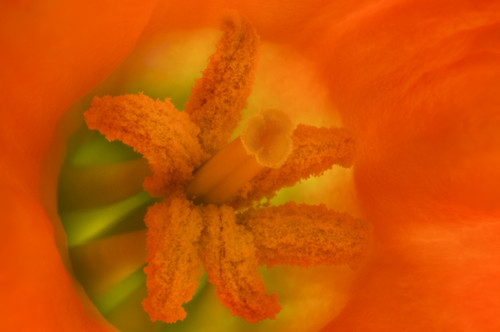
Daffodil, photo by Harold Davis. View this image larger.
If you’ve ever looked closely at a daffodil like this beautiful specimen, you’ll know that within the outer yellow petals is an orange “trumpet”. The trumpet itself contains the reproductive parts of the flower: ovaries, pistil, and the stigma, style, and anthers shown in this photo. You’ll know, from having observed the daffodil, that these reproductive parts are really, really tiny.
So tiny that when I photographed this flower indoors (to control wind) backlit with the bright light of the morning sun in our breakfast nook, I found I could not get both the style (which sticks out a bit) and the anthers (the things covered with pollen) in focus.
The solution is to extend the field of focus by taking multiple photographs, each with a different point of focus. Provided you use the same aperture in each exposure, it can be possible to combine the two images as layers in Photoshop, thus extending the field of focus. In this case, I took two captures, one focused on the style and one focused on the anthers.
This process is sometimes called focus “stacking”. But I figure, why not give it a high-fallutin descriptive term and acronym? Extending the dynamic, or exposure, range of an photo using multiple captures creates a High Dynamic Range (HDR) image. So why shouldn’t extending a photo’s focal range by stacking several captures create a High Focal Range (HFR) image? You heard it here first…
[Nikon D300, 200mm f/4 macro lens (300mm in 35mm terms), 36mm extension tube, +4 diopter close up filter, two exposures with different focal points, both at 1.6 seconds and f/36, ISO 100, tripod mounted.]
Pingback: Photoblog 2.0: » Photoblog 2.0 Archive: » Red Flowering Dogwood Blossom
Pingback: Photoblog 2.0: » Photoblog 2.0 Archive: » Gaillardia x grandiflora
Pingback: Photoblog 2.0: » Photoblog 2.0 Archive: » Day Lily in Morning Dew
Pingback: Drops of Rain | Photoblog 2.0